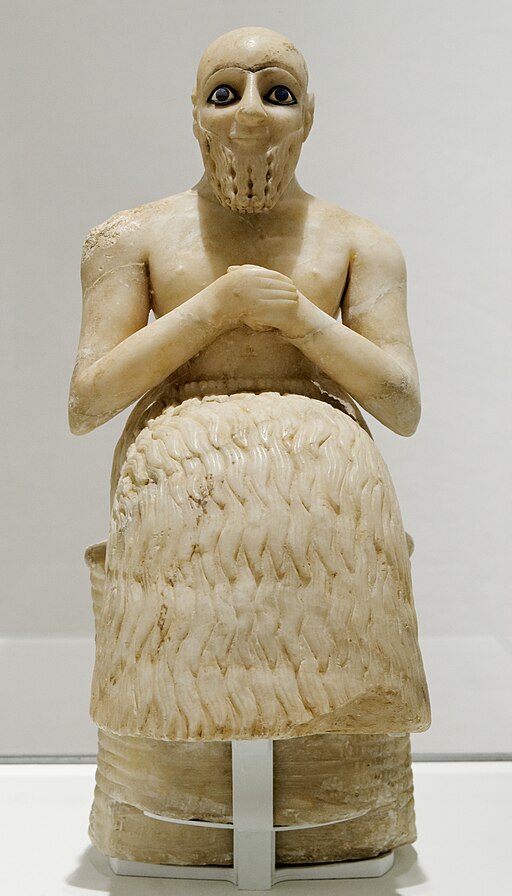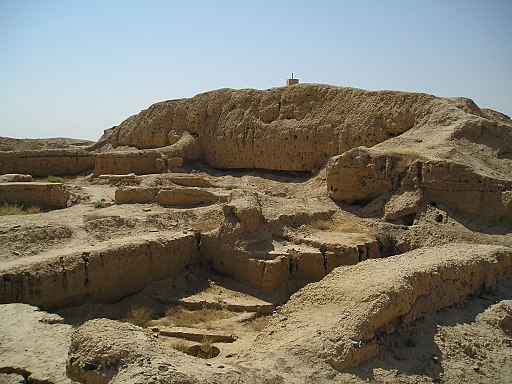
This statue depicts the figure of a praying man seated on a wicker seat with hands clasped against his chest in devotion to his deity.
The inscription in proto-cuneiform on the rear, which identifies the work, reads: “Statue of Ebih-Il, the superintendent, dedicated to Ishtar Virile.”
Ebih-Il was a superintendent of the ancient city-state of Mari in modern-day eastern Syria. The statue was discovered at the Temple of Ishtar in Mari during excavations. It is made of gypsum, with inlays of schist, shells, and lapis lazuli.
The man’s head is shaved. His long beard is composed of vertical curls and with holes drilled. The gaps in the beard had formerly been inlaid with another material that is now lost.
The beard accentuates the figure’s cheeks and finely sculpted lips that have a half-smile.
The figure’s blue eyes were crafted with particular care using a combination of schist, shells, and lapis lazuli to depict the eyelashes and eyelids, cornea, and iris, respectively. The lapis lazuli inlays used were imported from Afghanistan.
The figure has a bare torso, and the figure’s only dress is the Sumerian-style ceremonial woolen mantle skirt. The elaborate fleece skirt appears to be made from sheepskin or goatskin hide, as evidenced by the presence of a tail at the back.
The figure’s feet are missing, but their attachment piece is still showing under the dress.
The statue was discovered in two parts by a French archaeological excavation team. The head was found at the outer court of the Temple of Ishtar, and the body was found a few meters away.
When the statue was found, the left arm was broken, and the elbows were damaged. This statue was the first significant discovery in the excavations, started in 1933, at the site of Mari.
Mesopotamian Art
One fundamental intention of Mesopotamian Art was to honor the gods and goddesses.
The central place of worship was the ziggurat, a stepped pyramid with stairs leading to an altar where worshipers would elevate themselves closer to the heavens.
The Mesopotamians believed that their rulers had a direct link to their gods, and many artworks depict rulers in a glorified manner and supplication to the gods.
Mari, Syria
Mari was an ancient Semitic city in modern-day Syria. Its remains constitute Tell Hariri on the Euphrates river western bank. It flourished as a trade center and a hegemonic state between 2900 BC and 1759 BC.
Mari was a purposely-built city positioned in the middle of the Euphrates trade routes. This strategic location made it an intermediary between Sumer in the south and the Levant in the west.

Mari, Syria – the ruins of a Ziggurat near the Palace Ruins
Mari’s discovery in 1933 provided valuable insights into the geopolitical map of ancient Mesopotamia and Syria, due to the discovery of more than 25,000 tablets.
These tablets contained important information about the administration of state during the 2nd millennium BC and the nature of diplomatic relations between the political entities in the region.
They also revealed the extensive trading networks of the 18th century BC, which connected areas as far as Afghanistan in Southern Asia and Crete in the Mediterranean region.
Statue of Ebih-Il
- Title: Statue of Ebih-Il
- Created: 2340s BC
- Material: alabaster, seashell, bitumen, lapiz lazuli
- Culture: Akkadian Empire
- Discovered: 1898
- Place: Temple of Ishtar
- Height: Height: 52.5 cm (20.6 ″); Width: 20.6 cm (8.1 ″); Thickness: 30 cm (11.8 ″)
- Type: Statue
- Museum: The Louvre
Ebih-il : Syria 2300 bce
Statue of Ebih-Il
Highlights of the Louvre
- Egyptian Antiquities
- Hunters Palette
- Akhenaton and Nefertiti
- Seated Scribe
- Near Eastern Antiquities
- Law Code of Hammurabi
- Gudea, Prince of Lagash
- Victory Stele of Naram-Sin
- Statue of Ebih-Il
- Greek, Etruscan, and Roman Collections
- The Winged Victory of Samothrace
- Venus de Milo
- Sculpture
- Tomb of Philippe Pot
- “Rebellious Slave” by Michelangelo
Sumerian tell Asmar hoard
~~~
“The first duty of government is to protect the powerless from the powerful.”
– Hammurabi
~~~
Photo Credit: 1) Louvre Museum [Public domain] 2) Heretiq [CC BY-SA 2.5 (creativecommons.org/licenses/by-sa/2.5)]
Popular this Week








 Sponsor your Favorite Page
Sponsor your Favorite Page SEARCH Search for: Search Follow UsJoin – The JOM Membership Program
Sponsor a Masterpiece with YOUR NAME CHOICE for $5
Share this:
- Tweet
